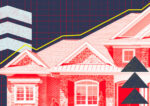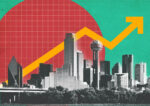After years of disruption, the Dallas-Fort Worth market is showing signs of stabilization. Persistent inventory levels since June and a potential Fed rate cut on the horizon suggest that, finally, brokers may begin to expect some stability.
“I think what we’re getting back to is a normal market cycle,” says Justin Landon, the CEO of North Texas’ MetroTex Association of Realtors, the MLS provider for the Dallas-Fort Worth market.
Sales volume has gradually declined each year between the second and third quarters since mid-2021, dropping 6 percent in 2022 and 10 percent last year. That pattern more closely aligns with the seasonal ebbs and flows the industry grew accustomed to before the pandemic, when the market slowed in the summer and winter months and ramped up again in the spring, after school started in the fall and in early December — but are this year’s trends truly signaling a return to normalcy, or are they just the symptoms of more disruption?
Summer slowdown drops hints
Even though the average rate on a 30-year fixed mortgage began declining in May and eventually dropped to its lowest level in over a year in August, Texas buyers entered the summer feeling cautious. Purchase lending in the second quarter saw the sharpest annual declines in San Antonio, down 32 percent year-over-year in the second quarter, just over Dallas’ 24 percent drop, followed by Austin and Houston’s declines above all the nation’s top cities, according to ATTOM.
Dallas real estate agents might see a quick response from buyers after a Fed rate cut, Landon said, despite foggy predictions on when or how mortgage rates will move after a potential lowering of interest rates next week.
The Fed’s 11 interest rate hikes since March 2022 followed disruptions that hit Texas cities hard. The pandemic downturn saw demand increase and housing supply dwindle, especially in job magnets like Dallas and Austin, as buyers flocked to Texas; the number of home sales in Austin exceeded the number of homes hitting the market almost every month from 2020 to mid-2022.
In Dallas-Fort Worth, there was just over a month of inventory on average throughout 2021 and 2022. This year, it’s sat at four months since the summer began, indicating to industry leaders that the supply and demand imbalance is starting to ease.
Median home prices skyrocketed to $425,000 in the second quarter of 2022 from $273,000 in 2020’s first quarter. This year, the median listing price has hovered around $405,000, unchanged year over year. Prices don’t show signs of a drastic change any time soon, Landon said.
Showing data also took a dip during the summer months, a pattern expected in a normal market but uncharacteristic of the last few tumultuous years, he said.
Robust sales in the spring is another sign of a normalized market — April kept realtors busy, with home sales up 7 percent year over year, while last year they dropped 8 percent year over year. Absorption was strong, and while months of inventory began inching up, it only rose 50 percent year over year compared to 115 percent year over year the same time last spring.
Fnu Milat of Citywide Properties in Dallas said he then noticed a lull this summer; nothing “crazy” like the frenzied buying in the last few summers, but a familiar slower pace as families use their summer vacations and prepare for the school year. A typical market should ramp up again after Labor Day.
“The potential homebuyers I’m speaking to are waiting for interest rates to come down,” Milat says. “I think it’s going to happen this month, and I think we’ll see a lot of people jump in after that.”
The wild card
A full return to the “normalcy” is a slow burn — not to mention that the expected peaks and valleys of the real estate market don’t look anything like they did before the 2008 recession.
“Well, what is normal?” Jim Fite of Century 21 Judge Fite said. “We haven’t had a normal market … since the great recession.”
A recent slowdown in buyers from California and New York to Dallas, and the four months of inventory, is among the trends that could lead to familiar seasonality returning, Fite said. That would depend on whether interest rates remain high enough to prevent quick inventory absorption during the usually slow winter months.
The market could take a hit — though it remains to be seen — if realtors can’t adjust quickly enough to the changes to NAR’s commission guidelines last month.
Texas brokerages have reported more administrative work and conversations with clients, and some experienced realtors have had to experiment with new ways of bridging the negotiation gap left open from changes to their multiple listing services at the least, Fite said.
Read more



Milat now sends 300 to 400 emails to local buyers’ agents every morning, he said, hoping to catch buyers amenable to his commission offerings.
“The wild card that we don’t know about … is the NAR settlement dominoes,” Fite said. “So far, our company is doing extremely well; we’re still getting multiple offers on properties — I won’t say it is as robust as it was two years ago, but there are a lot of people buying and selling real estate today.”
